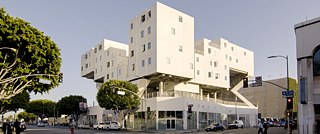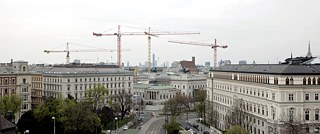Worlds of Homelessness
What It Takes to Make a Home

In many cities around the globe, the number of people without consistent access to shelter has increased to represent a significant percentage of the overall population. Today, the growing number of people migrating to cities, the economic pressure that augments the gap between the rich and the poor, and housing projects being turned into global commodities are just some causes of this new reality of inequality in cities across the globe. What does it mean to live in the city without a place you can call your own? What role can architects have in addressing homelessness? And how can cities become a better home for all?
The film What It Takes to Make a Home follows a conversation between architects Michael Maltzan (Los Angeles) and Alexander Hagner (Vienna), who have been grappling with these questions over many years and through various projects. While the cities and the political and economic contexts in which Maltzan and Hagner work differ, both search for long-term strategies for housing instead of reacting with ad hoc solutions. Focussing on some causes and conditions of homelessness, the film questions the role architects can play toward overcoming the stigmatization of people experiencing it, in order to build more inclusive cities.
“It’s hard not to become pessimistic and it’s reasonable to feel that way.”
Michael Maltzan
Architect Alexander Hagner, from the firm gaupenraub+/-, engages with similar questions in Vienna, a city that has, historically, been known for its long tradition of progressive social housing policies, but that has seen a significant increase in homelessness over the past years. Here, the housing crisis is less visible than in Los Angeles but is still a pressing urban issue. Stigmatization oftentimes averts society from helping those in need, concludes Hagner, who believes that creating a specific architecture for a segment of society inadvertently emphasizes the difference. Consequently, the housing project VinziRast-mittendrin designed by Hagner does not stand out at first sight. Yet, the project is exceptional, as it provides a prototype for a new form of community, in which students and individuals formerly without homes live together.
Overall, the film focuses on a condition that affects societies across the world and that architecture and urbanism cannot fail to address. Architects, as Hagner states, will not be able to solve the complex reality of homelessness, but they can help to frame life on different scales, supporting communities as well as individuals. Similarly, Maltzan is convinced that architects cannot escape engaging with those crucial spatial questions to bring positive change to the city.
What It Takes to Make a Home is the first of the three-part documentary series produced by the Canadian Centre for Architecture. This series examines the ways in which changing societies, new economic pressures, and increasing population density are affecting the homes of various communities. Through the lens of two architectural projects in two cities with different socio-political contexts, each episode looks at the global scope as well as the local specificities of a particular issue. While the first episode examines how architects are confronting the pressing issue of homelessness in Los Angeles and Vienna, the second and third parts of this series deal with other challenges to urban society created by changes in lifestyles and demographics that affect the spatial configuration of our environments: the increase of families consisting of one single person, and our growing aging society.





